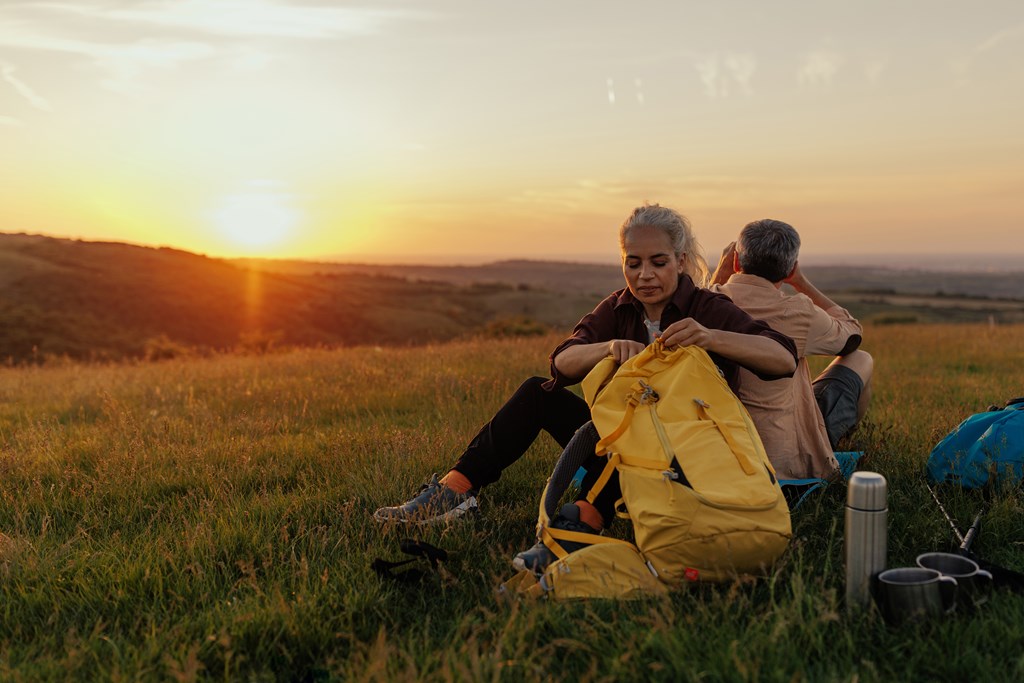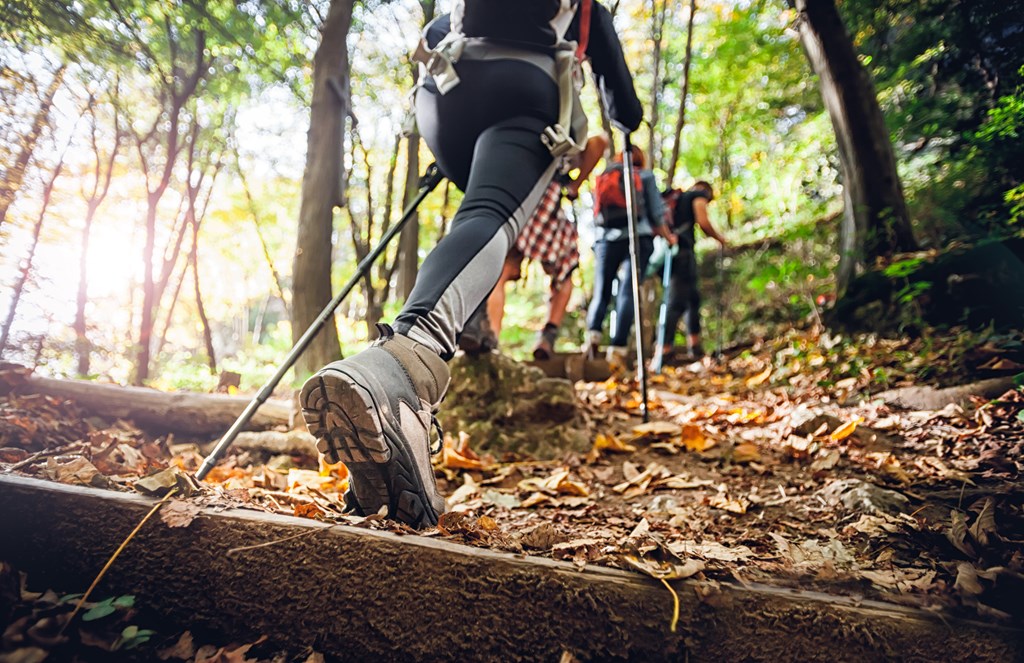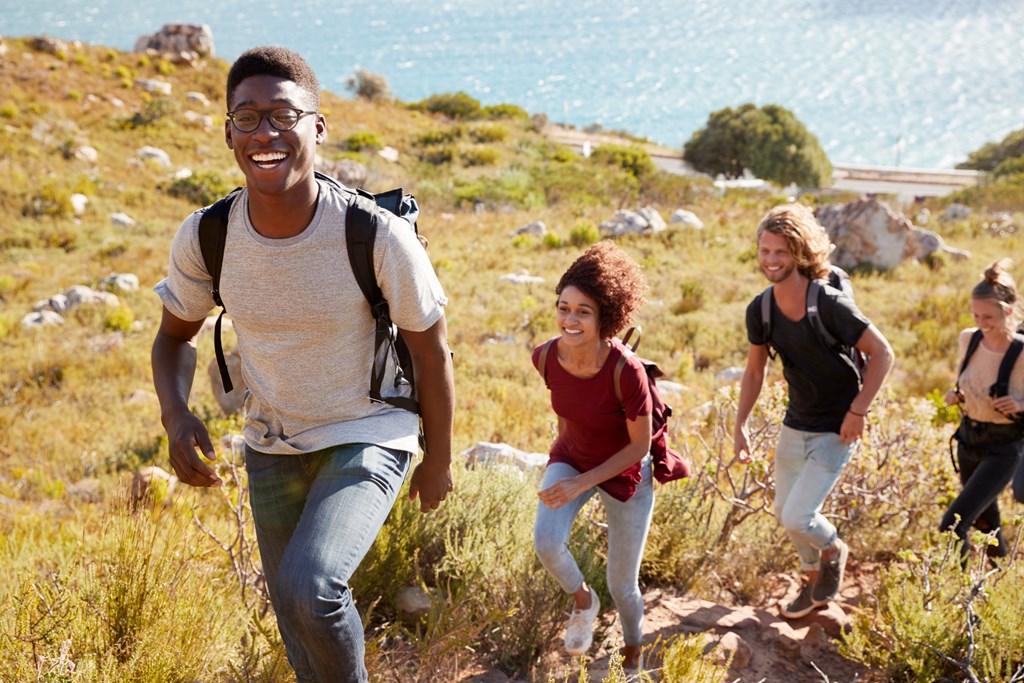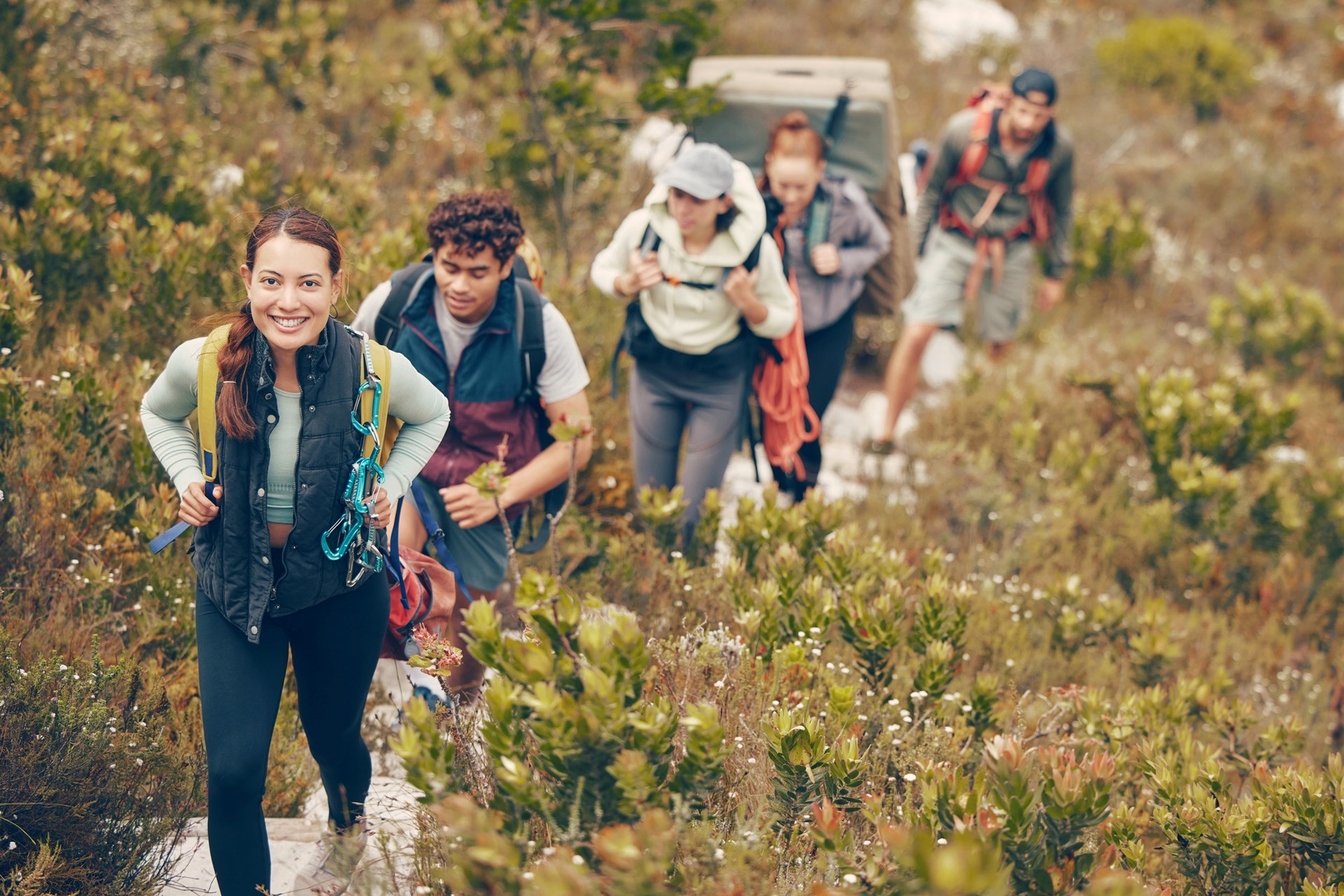How to Plan and Prepare for a Hike
Hiking is a fun, relaxing way to experience the great outdoors with friends and family. When you go on a hike, you get to explore places in nature that the roads cannot reach. Leave your worries about time, work and other stressors far behind and reawaken your sense of wonder. There is nothing like reconnecting with friends or loved ones on a journey through nature.
If you have never hiked before, you might feel intimidated by the idea. Maybe you are concerned you are not in shape to hike. Perhaps you are worried you will get lost and will not be able to find your way back. Rest assured — there is a hike out there for everyone. Hiking is not a race to the finish line, but a low-impact workout that is about enjoying good company and immersing yourself in the beauty of nature.
Hiking offers many health benefits, too, including help with weight management and stress reduction. Physical activity also decreases the risk of heart disease, hypertension and diabetes. If you are ready to start hiking, you are making an excellent choice for your overall well-being. Plus, getting started is easier than you might think.
In this guide, you will find everything you need to start hiking, from packing essentials to how to prepare for a day hike. With a little planning, you can enjoy a safe, comfortable and pleasurable hike.
Hiking Tips and Tricks for Beginners
A successful hike is simple when you have the right tools and a positive mindset. The first step is knowing what you need to go hiking, so you can feel great all day and keep your energy levels up.
What to Pack
What to Wear
What to Eat Before Hiking
Food to Bring
How to Plan Your Hiking Trip
Book a KOA
1. How to Get in Shape Before Your First Hike
While many people think that the easiest way to prepare for a hike is by going on a hike, you need to be in some physical shape before hitting the trail. Most hiking trails are uneven and have elevation gain, meaning you need to have a level of strength and balance to reduce the risk of injury.
Exercises to Help Build Your Strength Before Your First Hike
Rolled and sprained ankles are two of the most common hiking injuries. If this is your first time hiking or you have not been hiking in a while, you will want to perform the following basic exercises to help get your heart rate up:
- Run or walk in sand: Since sand constantly moves under your feet, it is a great way to practice walking on uneven terrain. It also helps build the muscles that protect your knees and ankles.
- Build range of motion: Hiking is more than simply walking forward. You may need to jump or move in other directions to avoid fallen trees. Standing on a tennis ball or balance disc can help increase your range of motion while building the small stabilizer muscles surrounding the ankle and knee.
- Crunches: Your core provides stability for all movement and will help you keep your balance on uneven surfaces such as rocks or trees.
- Squats and lunges: Doing squats and lunges strengthens your legs and can increase your core strength. As you squat or lunge, make sure to keep your back straight.
- Push-ups: Improving your upper body strength with push-ups can make carrying a heavier backpack on longer trips easier.
- Cardio: Getting your heart rate up by walking or cycling can help to increase your lung capacity so you can hike longer.
- Step-ups: Before hiking, you will want to weigh your backpack with all your gear inside and wear it as you do step-ups. This will ensure you can easily carry your bag and supplies as you make your way along the hiking trail.
Tips for Getting in Shape for Your Hike
Some additional tips to keep in mind to ensure your hiking trip is a success include:
- Give yourself about a month to prepare for your hiking trip and perform at least one of the exercises above at least once a week.
- As you perform the exercises, wear the same hiking boots or sneakers you will wear on your trip.
- You may want to include weights in your exercise plan to help increase your overall strength.
 2. What to Pack For Your First Hiking Trip
2. What to Pack For Your First Hiking Trip
Packing for a short hike does not require too much. After all, you will be carrying everything with you during your hike, so the lighter you pack, the better. However, you will need a few essential items if you plan on hiking all day. Here is a hiking gear list to use as your packing guide for what you need to go hiking:
-
- Navigation Tools: Make sure to bring a map, compass or GPS for your hiking trip. You will want to know where you are and where you are going at all times, but you will also want to know where all the campsites, emergency exits, water sources and rest areas are located. The American Hiking Society recommends bringing along a map or compass — even if you have a GPS as a backup. When you know what to expect, you can plan other details better and enjoy the hike without worrying about getting lost.
- Adequate Water: Water is perhaps the most important item on your hiking gear list. Without enough water, your body cannot perform at its best. Make sure to hydrate before the hiking trip and sip water throughout the day. Whether it is cold or hot outside, an adequate water supply should always be a priority.
- Adequate Food: You want the hiking experience to be as fun as possible, and everyone is happier when their bellies are full. Bring along extra snacks so you and your hiking companions can enjoy long moments near a mountain stream.
- Clothing and Rain Protection: Sometimes, no matter how much you plan, the weather proves the forecast wrong. You cannot always predict a sudden storm or rain shower, but you can prepare for surprises. To solve this problem, pack a lightweight poncho or dress in layers so you can adjust to temperature changes easily.
- Safety Items: If you are hiking an easy, well-maintained trail that sees a lot of foot traffic, you may not be as worried about safety. No matter what you anticipate your hike to be like, you will want to include a firestarter, a flashlight and a whistle in your safety kit, so you are prepared for any situation. A fire can signal for help and keep you warm, a whistle calls for help and a flashlight will guide you in the dark.
- First-Aid Kit: Build a personalized first-aid kit, which might include blister treatment, bandages, tape, antibiotic ointment, gauze pads and any medications that you or your companions may need.
- Multi-Purpose Tool or Knife: Another hiking must-have is a knife or multi-purpose tool. You never know when you might need to cut fabric to make bandages or even just open a stubborn package of trail mix. A knife can also come in handy if you need to make a fire.
- Sun Protection: Bring along sunscreen to protect your skin from sunburn and ultraviolet (UV) radiation and do not forget sunglasses to shield your eyes. Use a broad-spectrum sunscreen that is SPF 15 or higher and sunglasses that provide 99 to 100 percent ultraviolet A (UVA) and ultraviolet B (UVB) protection. If possible, aim to hike on shaded trails between 10 a.m. and 4 p.m. when the sun shines strong, and use mornings for open-area hikes. Reapply sunscreen every two hours or more if you are sweating a lot.
- Backpack: Choose a pack that feels comfortable for you and that will not put excess strain on your back and shoulders. Always wear both shoulder straps, and make sure the backpack rests close to your body and high on your back. Backpacks with padded, adjustable hip belts are great for hiking, as they take the strain off of your shoulders and back.
- Trash Bag: Pack a trash bag to keep the trails you trek beautiful, clean and free of garbage. A zippered plastic bag is perfect for containing wrappers and other trash until you get back. Be sure to help younger hikers dispose of their trash properly.
- Bug Spray: Ticks, bees, spiders and mosquitoes are some of the insects you might encounter on your hike, depending on where you go, the time of day and the season. However, you do not have to let these pests ruin a great hike. In buggy areas, you can use DEET insect repellent. Be sure to reapply frequently. DEET is not suitable for small children, so choose an alternative like citronella spray for the kids.
Toiletries: If you plan to hike far away from public restrooms, prepare for bathroom breaks by bringing toilet paper, hand sanitizer, waste bags and any other necessities.

3. What to Wear Hiking
What you wear on your hike will have a significant impact on your experience. The wrong shoes can lead to sore feet and a short hike. Similarly, heavy pants can be uncomfortable on a hot day, but shorts do not provide the best protection against skin-irritating plants and insects. Here are some tips on what you need to wear for the most comfortable hiking experience.
What Pants to Wear Hiking
The best pants to wear for a hike are those that are breathable and help keep you cool or warm depending on the temperature. Above all else, you want to wear pants that are comfortable. For these reasons, it is best to avoid denim when hiking. Your favorite pair of jeans may be fine for a short, casual walk, but for longer hikes, they can be uncomfortable. In the winter, jeans alone will not keep you warm, and in the summer they absorb water and are slow to dry. Plus, they will make you hot and the heavy seams could lead to irritated skin.
In the winter, the trick is to wear layers to keep warm. You might put on leggings or long underwear beneath a pair of hiking pants made of wicking fabric, which keeps you dry and comfortable.
In the summer, avoid shorts if you plan to hike in the woods. Instead, wear a pair of lightweight pants to better protect yourself against skin irritation or bug bites.
Choosing the Best Hiking Shoes
Choosing the right pair of hiking shoes is vital to a successful hike. With so many different shoes to choose from, how do you know which pair to wear? Here are a few factors to consider to make your decision simple:
- Terrain: If you plan to hike on mild terrain, light hiking shoes should work just fine. However, if you are going to traverse tough mountainous or snowy terrain, you may want to invest in more rugged mountaineering boots. If your hike falls somewhere in-between, backpacking boots with a solid sole can handle a range of landscapes.
- Material: Synthetic materials like nylon and polyester are breathable, easier to break in and lighter-weight. Split-grain leather boots are made half with leather and half with synthetic material, which means they are still breathable. Full-grain leather boots are heavier and less breathable, but extremely durable. They are best for experienced hikers planning to journey over challenging terrain.
- Cut: Low-cut boots are similar to running shoes — they are lightweight and suitable for beginning hikers planning to trek well-maintained trails. Mid-cut boots offer more ankle support and protection from weeds and other trail-side hazards. Meanwhile, high-cut boots provide the greatest level of balance and support and are ideal for hikers planning to go off on more challenging terrain.
In general, beginners are usually safe going with a more light-weight and comfortable pair of hiking shoes. However, once they build up their skills and are ready for rockier terrain, it may be time for heavier, more supportive boots.
No matter the type of hiking shoes you choose, keep these tips in mind:
- Lace boots snugly to prevent movement and blisters
- Wear wool or synthetic socks to protect against blisters and insects
- Always break in new shoes before heading out on a hike
- Look for shoes that offer excellent support
- Bring a blister kit just in case
- Waterproof your hiking shoes if possible
- Make sure you have plenty of wiggle room for your toes
- Ensure your boots fit snugly around the ball of your foot and that your heel will not move around
- Try on the hiking shoes with the socks you plan to wear to get an accurate fit
Other Hiking Clothing Tips
In addition to pant and hiking shoes, here are a few more clothing-related tips to ensure happy hiking:
- Dress in layers
- Bring a hat
- Wear tall socks for extra protection
- Avoid cotton because it holds moisture
- Opt for light-colored clothing, which helps you see ticks and other bugs more easily

4. What to Eat Before a Hike
When you hike or engage in any physical activity, you generally need to consume more food and water than you usually would. Your body needs fuel before and during a hike to replenish your energy, and you also need food after a hike to help your muscles recover. Just as you would not drive a car on empty, you do not want to strap on your hiking shoes without eating and drinking enough first.
The American Heart Association recommends eating two hours before exercising. In addition to plenty of water to help you stay hydrated, your pre-hike meal should include healthy carbs, such as:
- Whole-wheat toast
- Low-fat or fat-free yogurt
- Whole-grain pasta
- Whole-grain cereals
- Fruits and vegetables
- Brown rice
Although protein is often associated with a workout, you want to avoid loading up on saturated fats and proteins before a hike, as they take longer to digest and could make you feel sluggish. Instead, focus on consuming easy-to-digest complex carbs.
Protein is best consumed about 20 to 60 minutes after a workout or strenuous hike because it will help repair and grow your muscles. Just remember, these are only general rules — the most important thing is to do what is best for you and your body.

5. What Food to Bring Hiking
As a beginner hiker, you may not feel the need to drink much water. Whether your hike is easy or strenuous, it is always a good idea to stay hydrated by frequently taking small sips of water during your hike. Aim to drink at least 32 ounces before hitting the trails, and bring enough to drink about 16 ounces for every hour of hiking.
If you plan a hike that is less than an hour long, you may not need to take food. Otherwise, keep your energy going by eating 50 to 100 calories of carbohydrates every half hour. If you wish to bring perishable foods, use an ice pack to keep everything below 40°F.
Looking for healthy hiking snack ideas? Here is a list of snacks that are lightweight, nutritious, non-perishable and easy to eat while walking, but also enjoyable during moments of rest:
- Trail mix
- Dried fruit
- Granola bars or granola
- Bananas
- Nut butter, nuts or seeds
- Dried or freeze-dried vegetables
- Whole-grain tortillas
- Dried beans
- Cereal

6. How to Plan Your First Hiking Trip
The scent of nature and the feeling of fresh earth beneath your feet, the soothing sound of a babbling creek and a world free of schedules, emails and obligations — are you ready to go hiking? By this point, you are probably excited to immerse yourself in nature, but you might still feel a bit nervous. How do you plan a hiking trip everyone in your group can enjoy? Where do you begin?
Usually, planning a hiking trip is easy — especially with the abundance of online resources available. Remember to consider these factors, and you will be ready to go:
- Locating the Trail: You will not start your hiking adventure by hopping in the car and searching for a path along the road. While there is nothing wrong with a little spontaneity, it could be difficult to stumble upon the perfect trail for your needs. Instead, check online before you hit the trail. The web is full of excellent hiking websites with helpful information that allow you to search for trails near you. Many of them also indicate whether a path is easy, moderate or difficult. You might even learn how long the trail typically takes to complete, how to access it, parking information and more. Look up maps of the path to help you plan your day.
- Time: Ask yourself how much time you want to spend on your hike. Are you looking for a trail you can finish between brunch and a movie? Or are you planning on hiking from dawn to dusk? Also, consider how long it takes to get to the trail and how elevation will affect timing. For every 1000 feet of elevation, add around an hour to your hiking trip.
- Your Fitness Level: If you are new to hiking, it might be best to start slow. You want to have an enjoyable experience, so it is important to choose a trail you can handle and give yourself time to build up to more difficult trails. Remember to think about the fitness levels of friends and family who plan to come along, too.
- Distance: A brisk walking pace is about 3 to 4.5 miles per hour, according to the Centers for Disease Control and Prevention (CDC). Anything less than 3 miles per hour is considered a leisurely walking pace. So, if you find a trail that is six miles long, it could take you about two hours to complete it if you walk relatively fast. Ask yourself what you are comfortable with distance-wise, and also consider that certain types of terrain can affect your pace. For example, steep hills can slow you down to about 1 mile per hour. Depending on your fitness level, you may want to start with shorter distances to get a feel for what you can handle before committing to miles of trails.
- Weather and Time of Year: Always check the weather forecast before a hike so you can dress appropriately. Also, plan according to the time of the year. No matter your skill or fitness level, you should always avoid hiking new trails in the dark.
- Characteristics of the Trail: Become familiar with your trail before you start the hike. Look at maps or brochures so you can consider length, difficulty level, elevation and terrain. Think about where you will park and where the restrooms are. You can also decide whether you want to take a loop trail, so you wind up back where you started, or a straight path that will require you to retrace your steps.

Other Hiking Tips and Tricks
A beginner’s hiking trail mostly requires comfortable shoes, water, adequate snacks and a hiking buddy. However, here are a few final tips to keep in mind:
- Let someone know of your hiking plans
- Only take what’s necessary for a safe, enjoyable hike to avoid carrying too much weight
- Always bring enough water
- Choose a trail you can handle and give yourself time to build up to more difficult levels
- Hike with a companion
- Bring your cell phone in case of an emergency, but turn it off when you are not using it to conserve battery
- Always stay on the designated trail
- Stretch your body for five minutes before a hike
Most importantly, set your worries aside and plan to have fun, relax and enjoy the great outdoors. Remember, you can take your time and explore at your own pace — when you are in nature, there is no hurry. Instead, it is a time to reconnect with friends, family and the beauty of nature.
Make a KOA Campground Your Home Base
Planning a day hike is not just for experienced hikers ready to take on the world’s most challenging terrains. Anyone can hike — it is fun and requires very little except your own two feet. You could hike at a trail near your home for 20 minutes, or spend a few days hiking with friends from a Kampgrounds of America campground. The choice is yours.
If you are excited to hike, explore and leave the world behind, bring your friends and family to KOA. KOA Campgrounds are conveniently located near top hiking destinations across the country, so you are never far from a great experience. After a day of hiking, a KOA Campground is the perfect place to unwind, rest your feet and reminisce about the day’s adventures.
KOA Campgrounds are great for beginning hikers and experienced hikers alike, including friends, families and couples. At KOA, expect a comfortable and affordable camping experience with tons of fun activities to suit everyone’s taste. Toast marshmallows under the stars or participate in other campground activities. Cool off after a hike with a shower in your Deluxe Cabin’s private bathroom, or kick back with friends around a crackling fire.
KOA Campgrounds offer many lodging options for nature-lovers, families or anyone with an adventurous spirit. For the perfect camping experience that is affordable, convenient and fun, search for a KOA location and reserve your campsite today!
About the Author: Kampgrounds of America
Kampgrounds of America is the largest system of open-to-the-public campgrounds in the world, with over 500 locations across the United States and Canada. Founded in Billings, MT in 1962, KOA’s family of campground brands – KOA Journey, KOA Holiday and KOA Resort – today serve more than a million camping families each year. KOA is dedicated to “connecting people to the outdoors and each other” by providing people with a variety of camping experiences and the information they need to make the most of their camping trip. Read more of their camping and travel resources by visiting KOA.com/blog.
























